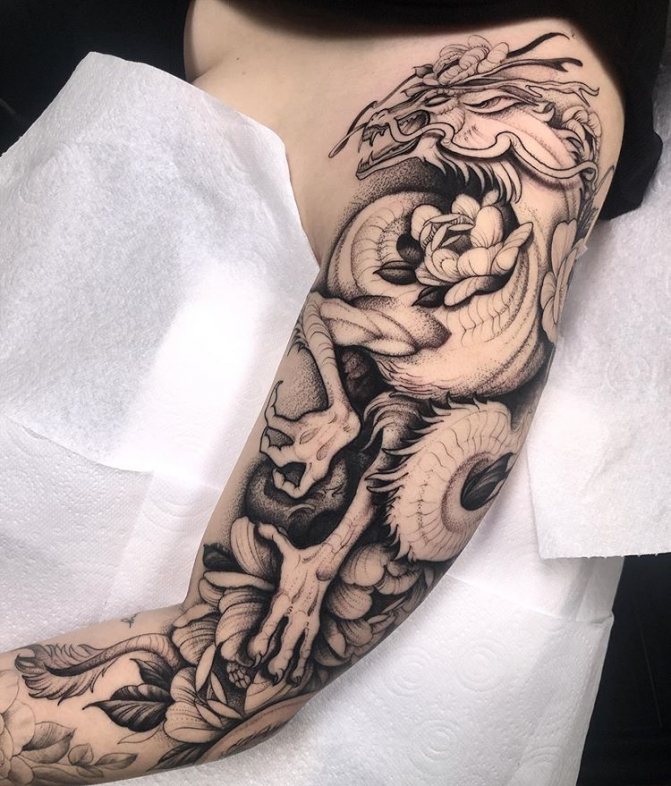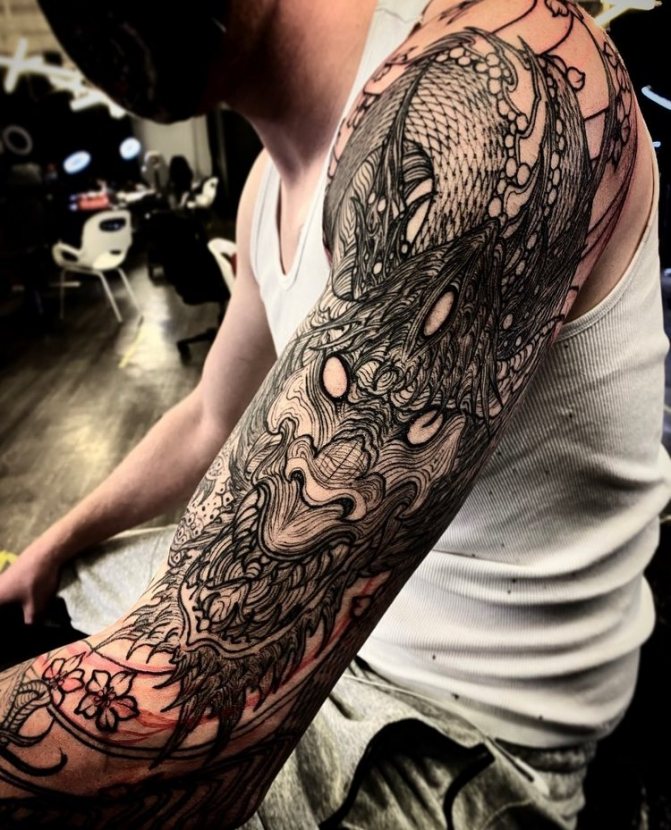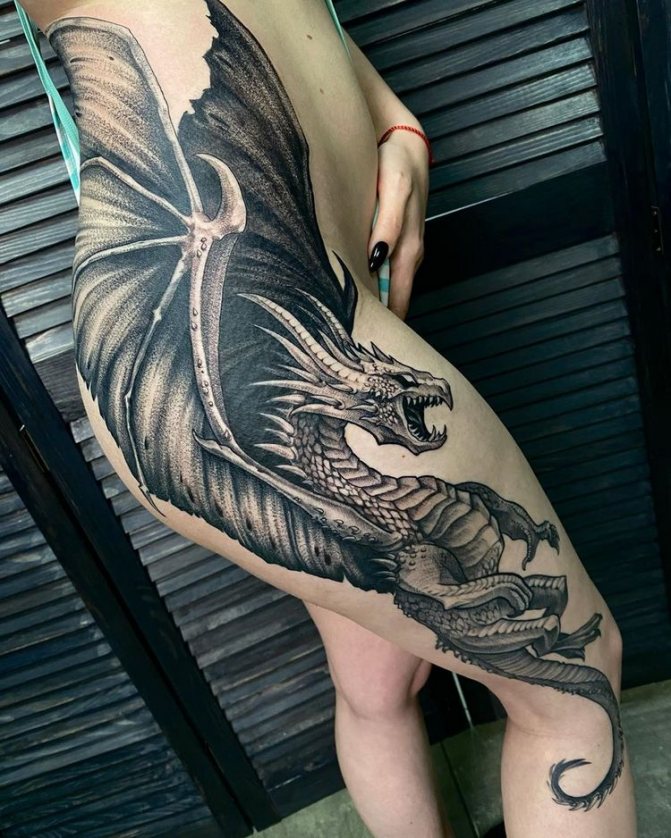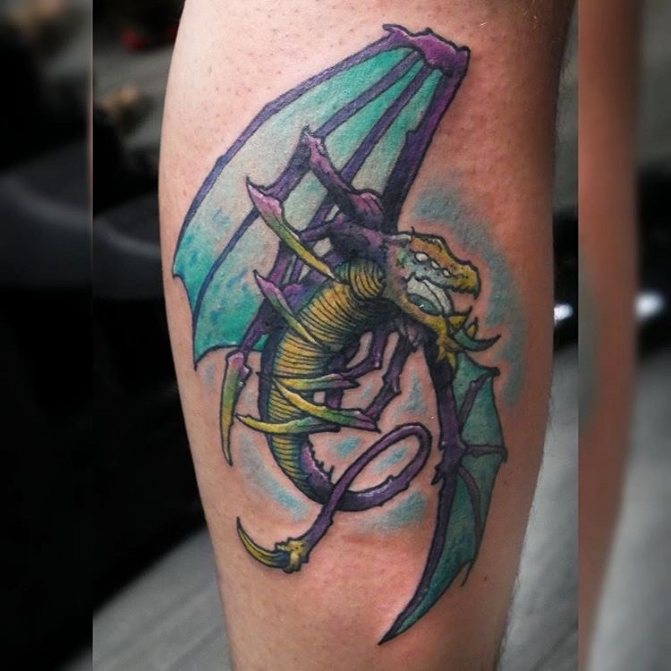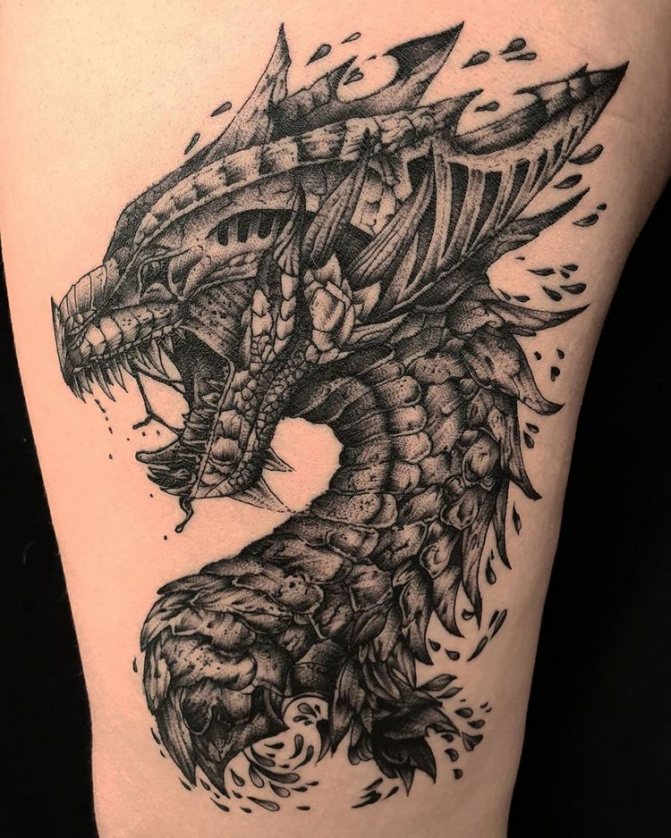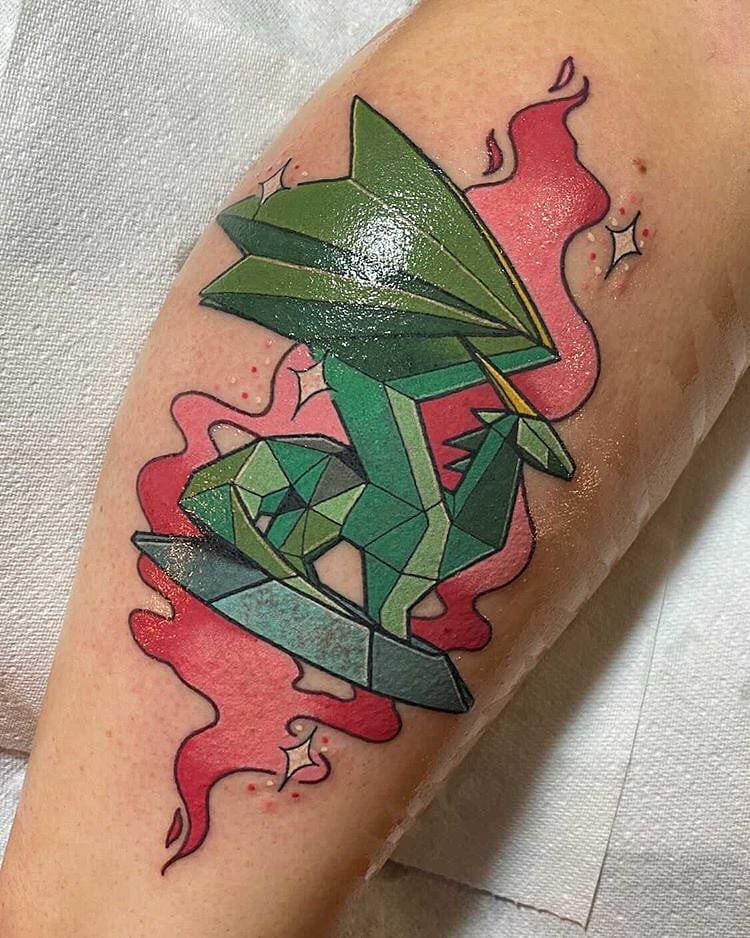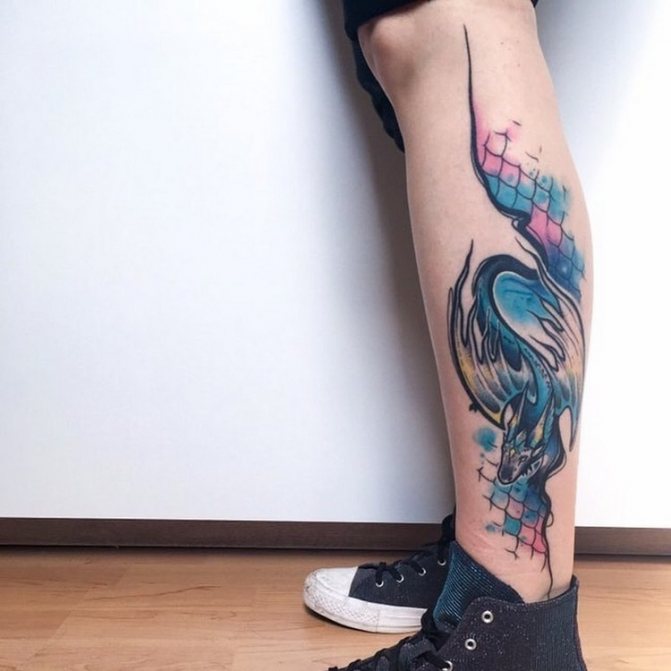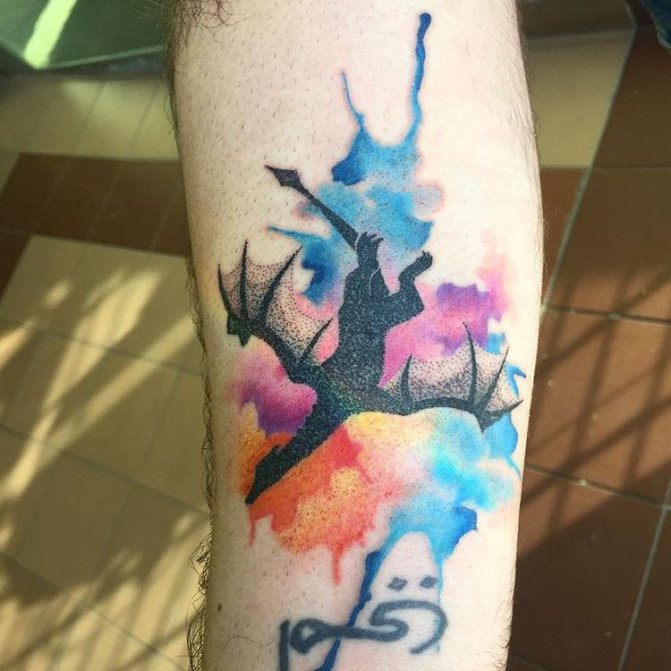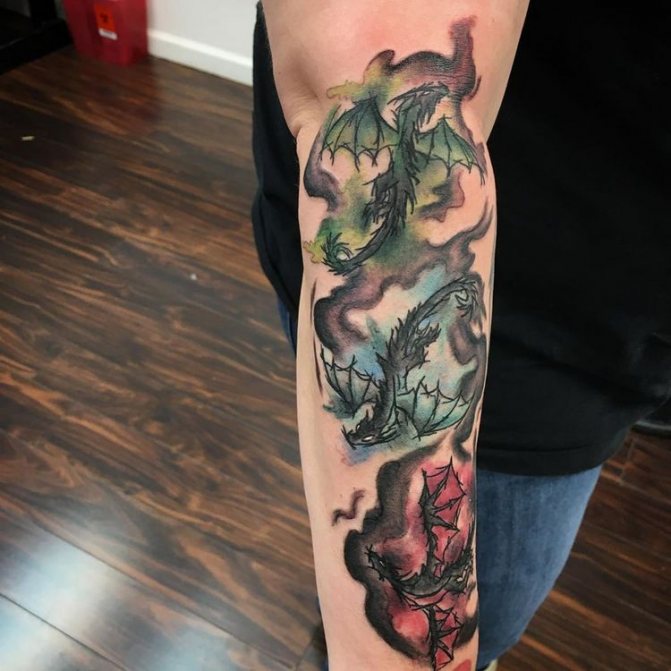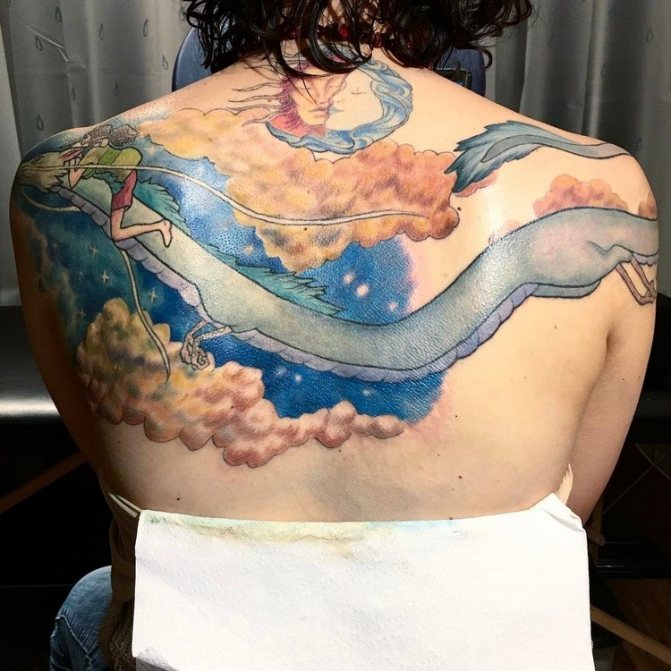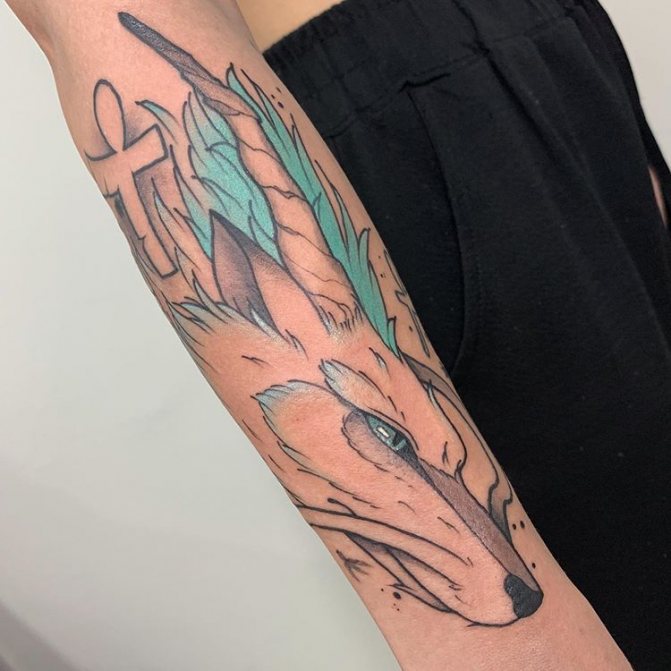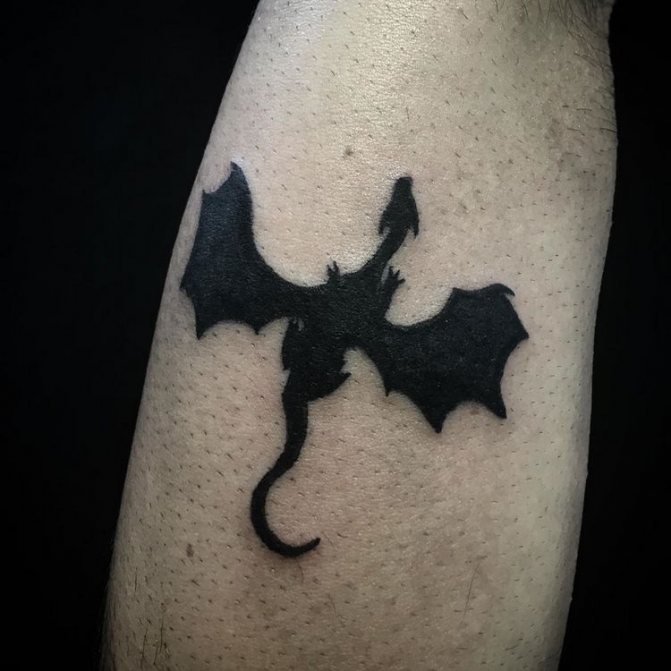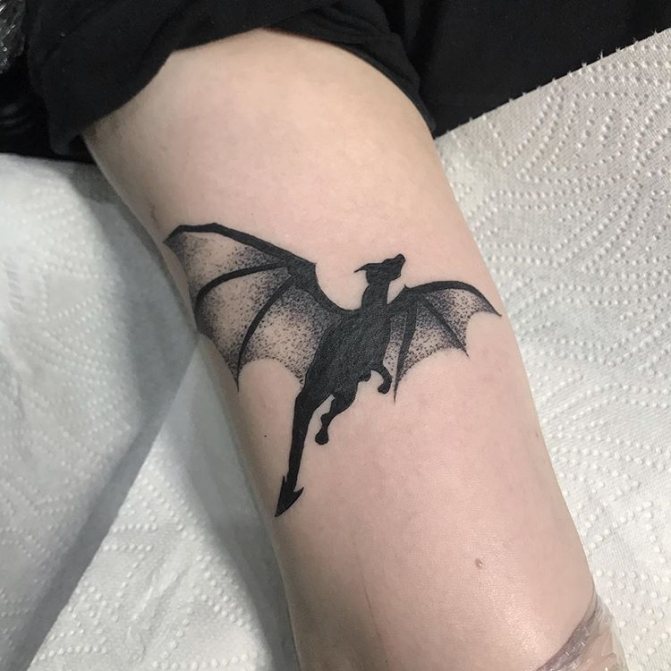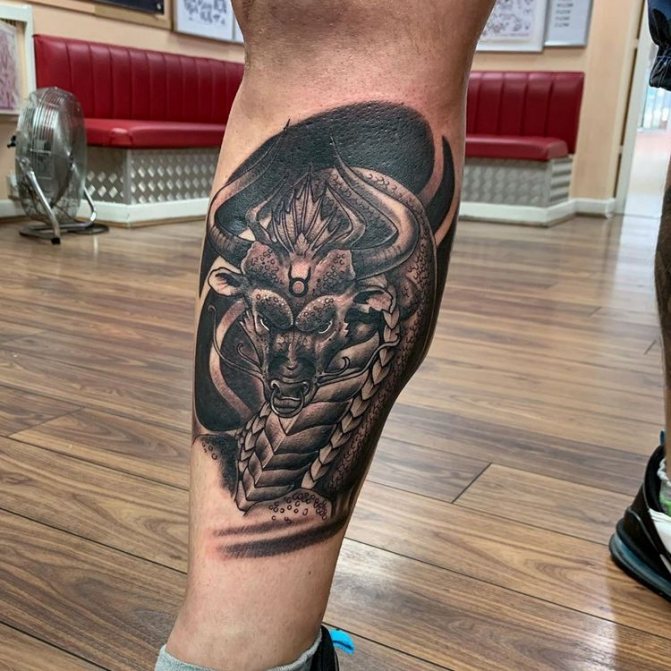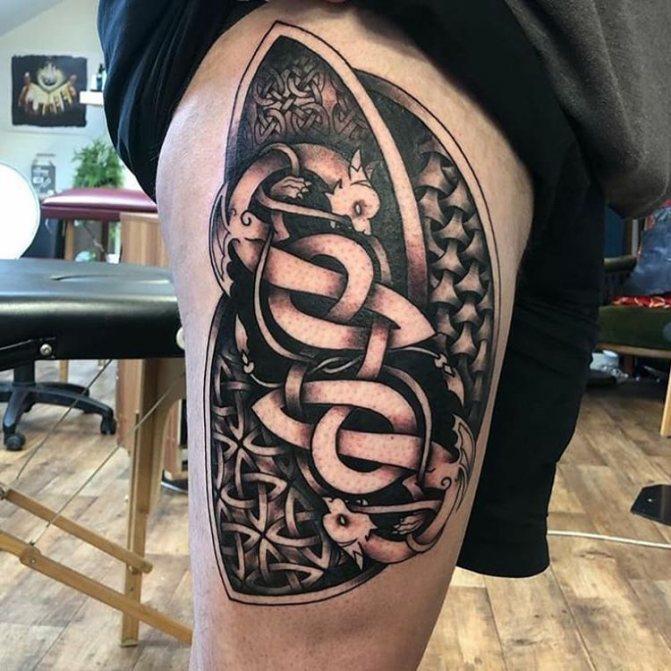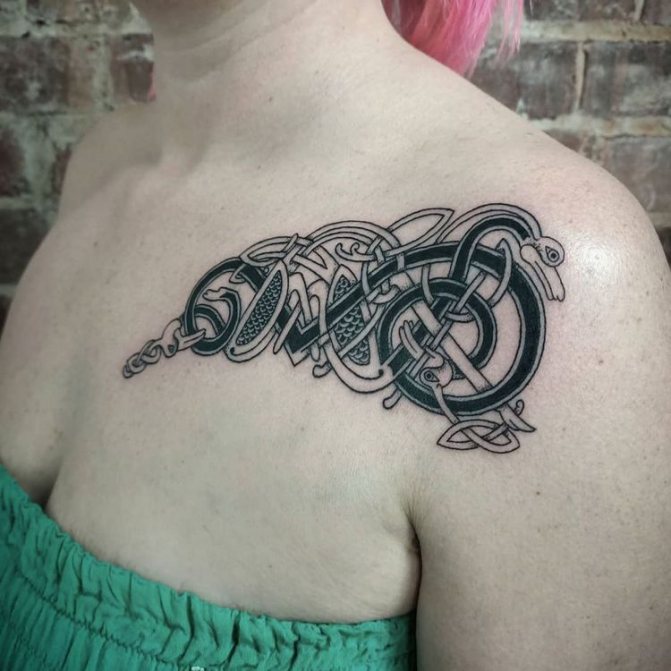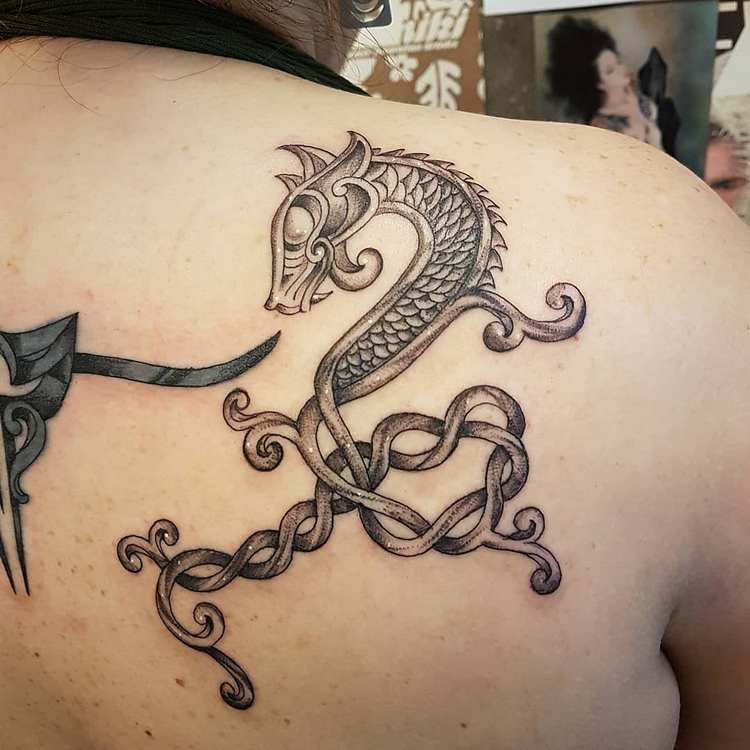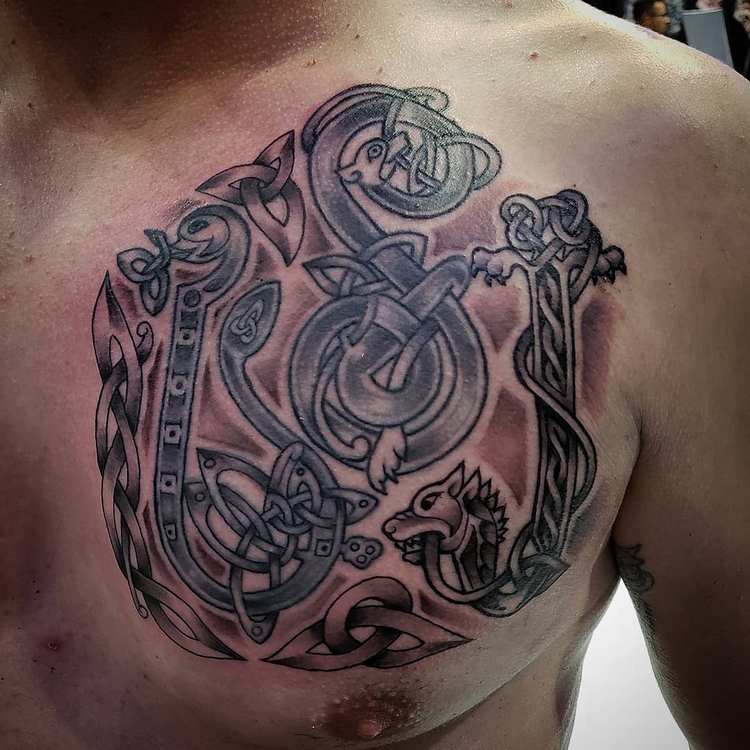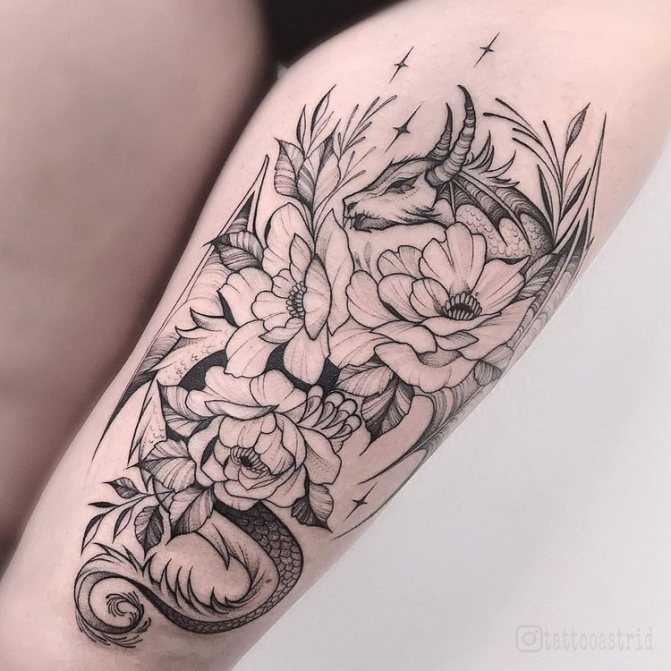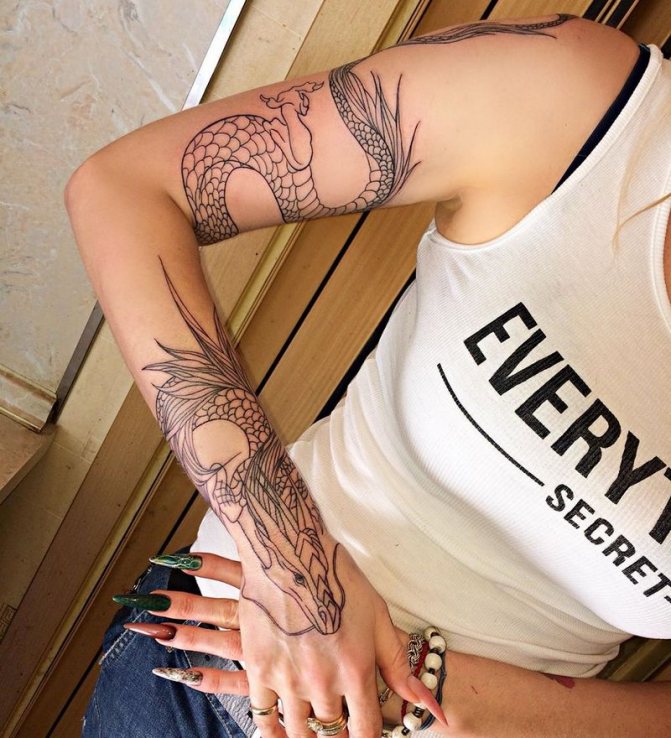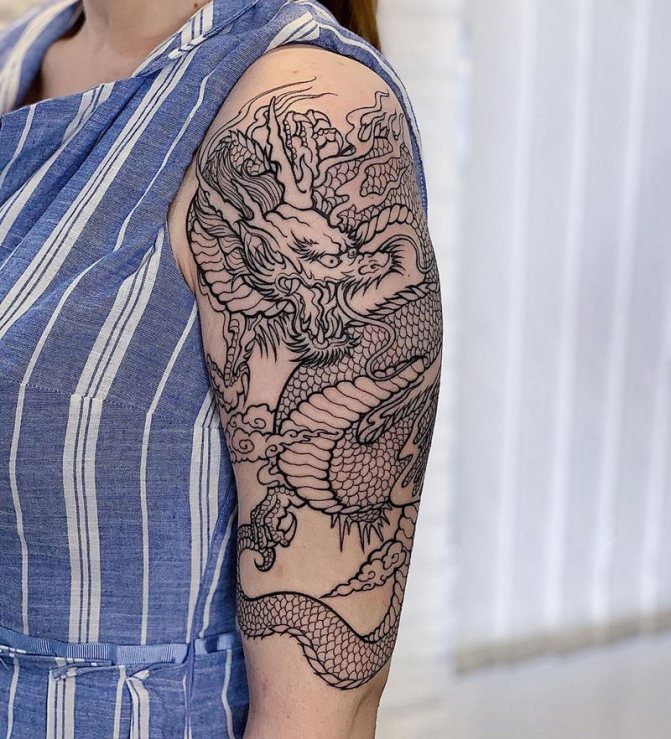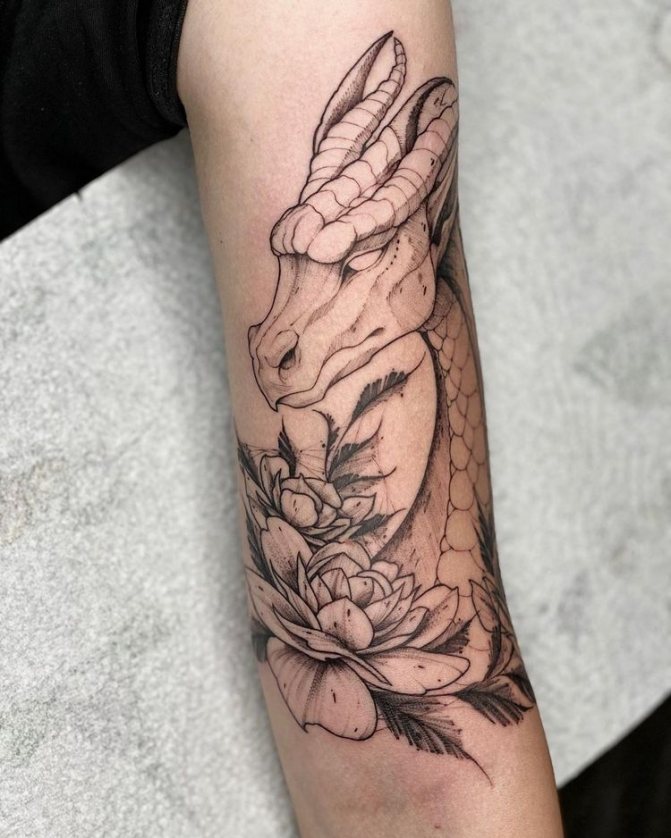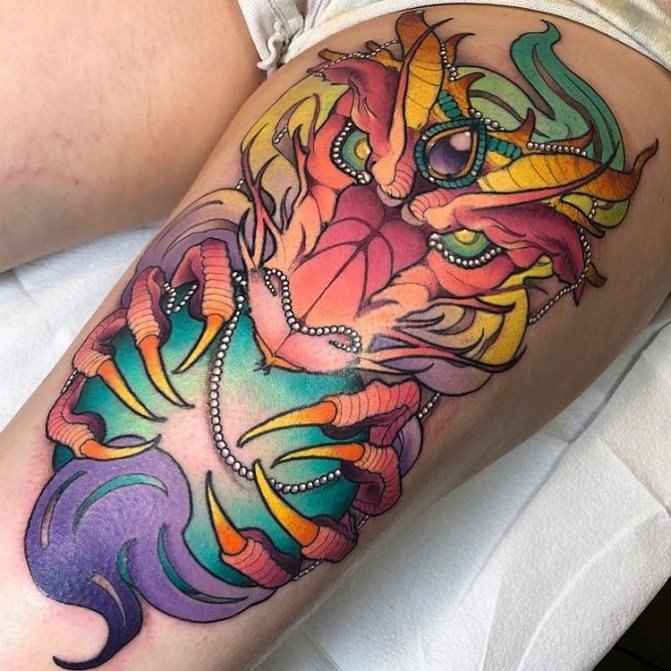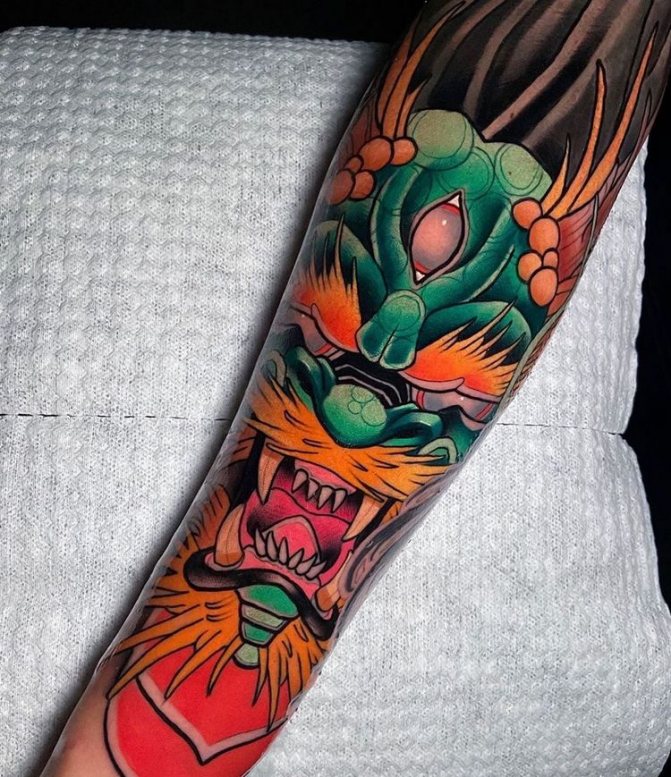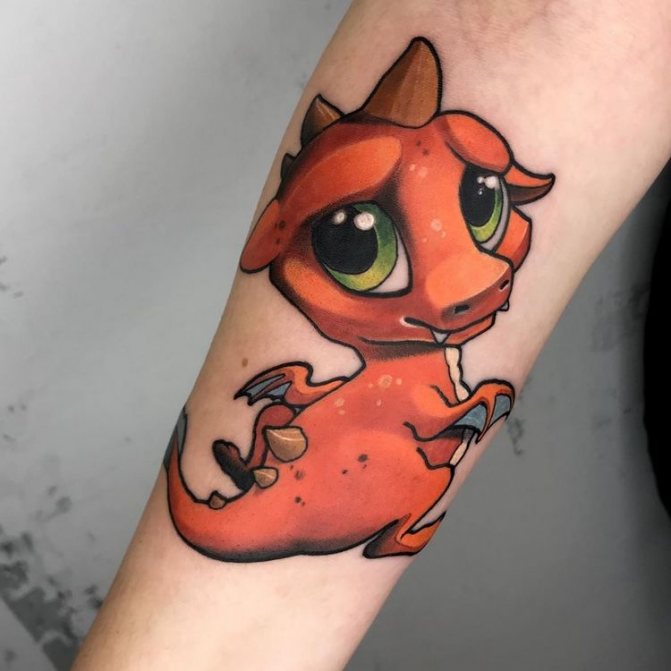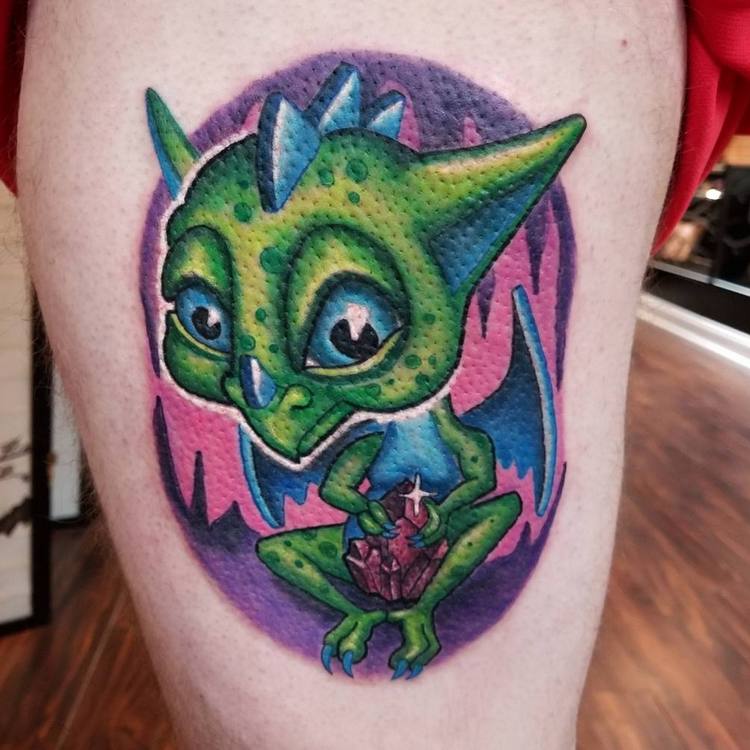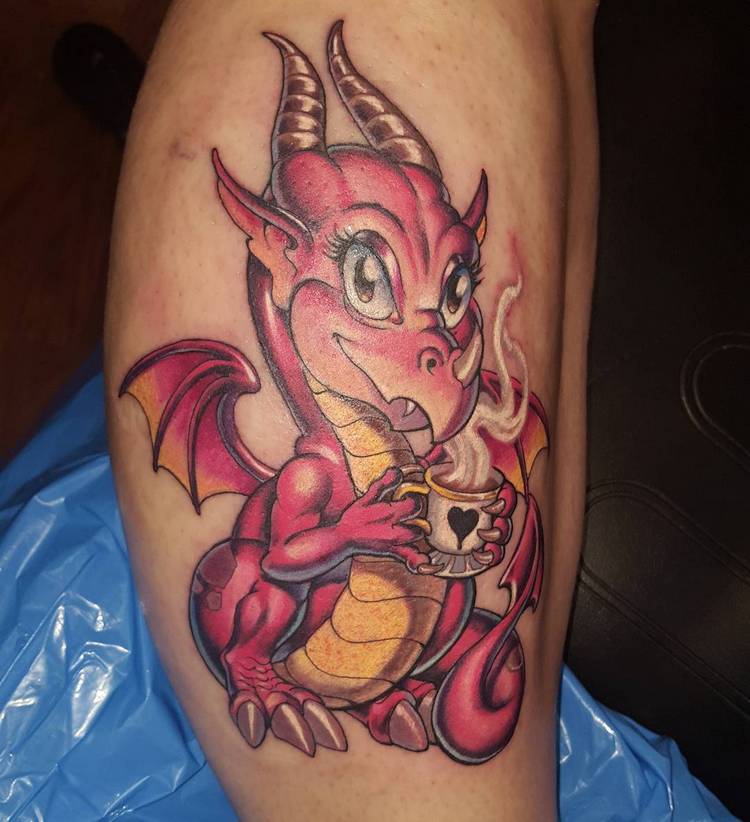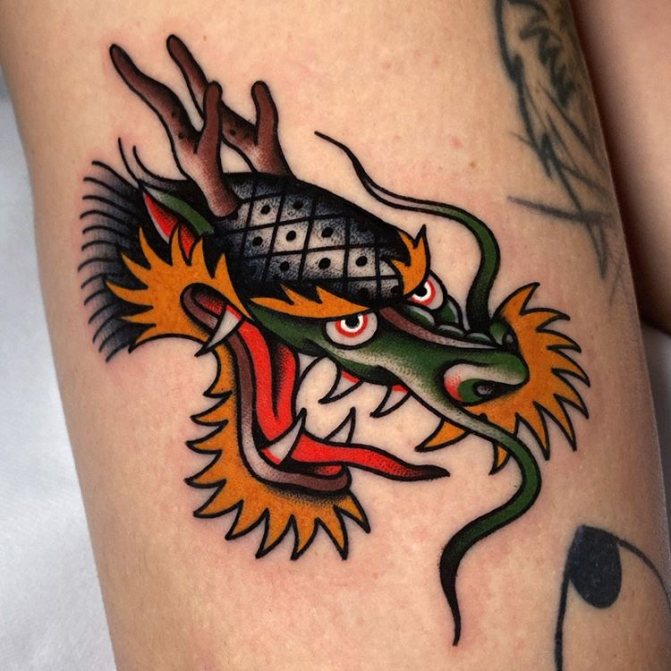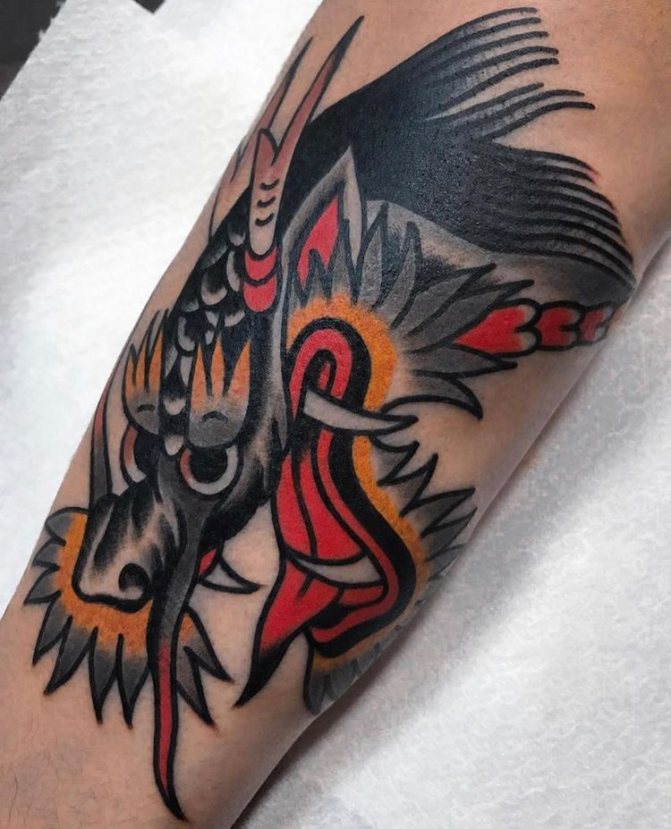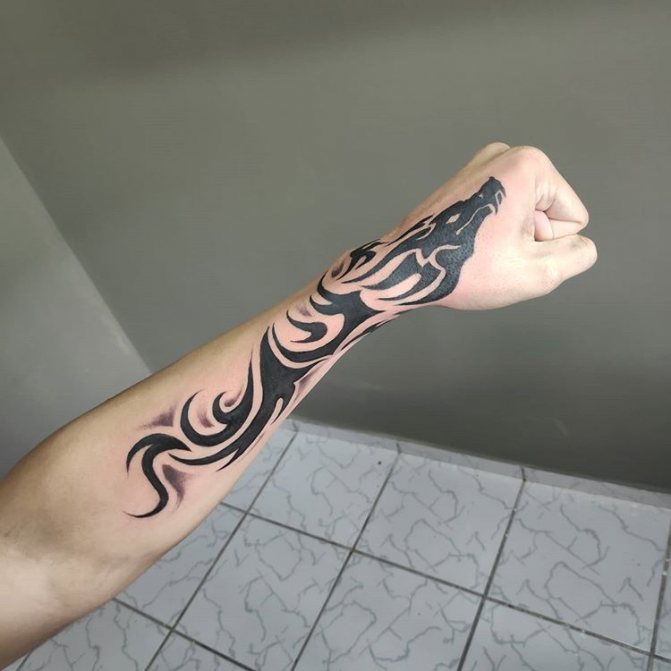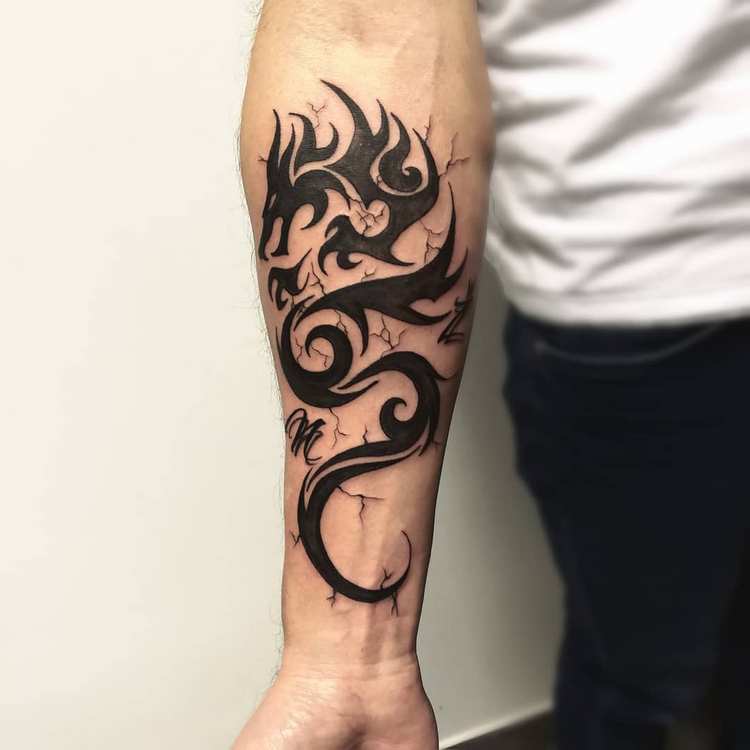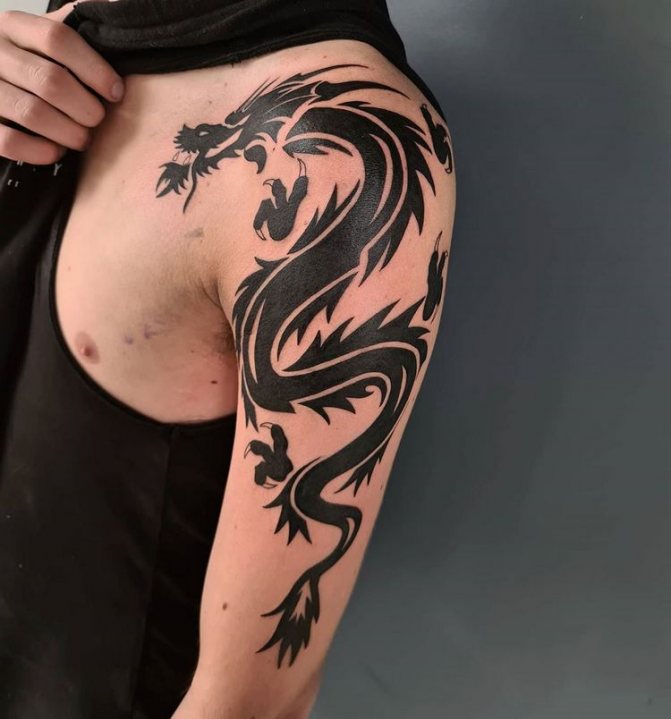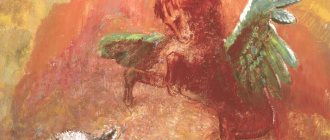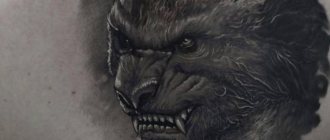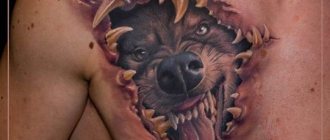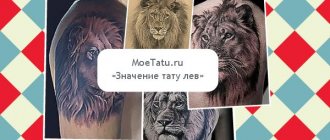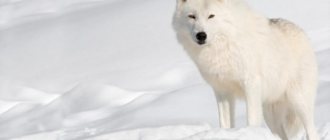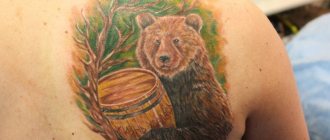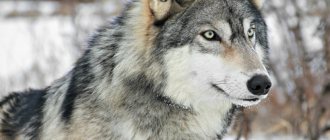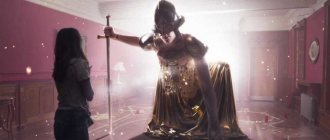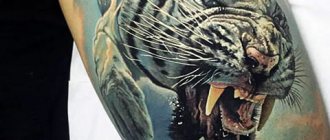The Dragon tattoo is a skin drawing of a mystical creature that has left an imprint in almost every cultural heritage of the world. It has its own canonical appearance in different parts of the world, but there are claims that there is no single image and each drawn image is individual.
Its similarity between the various images is reflected in the characteristic nuances that stirred the imaginations of medieval artists. They are just the people who told the world about how this nonexistent kind of negative heroes of legends, fairy tales, sagas and tales looks like, who nowadays became the most popular characters for dragon tattoo compositions on all parts of the body.
The external image of the dragon in a tattoo
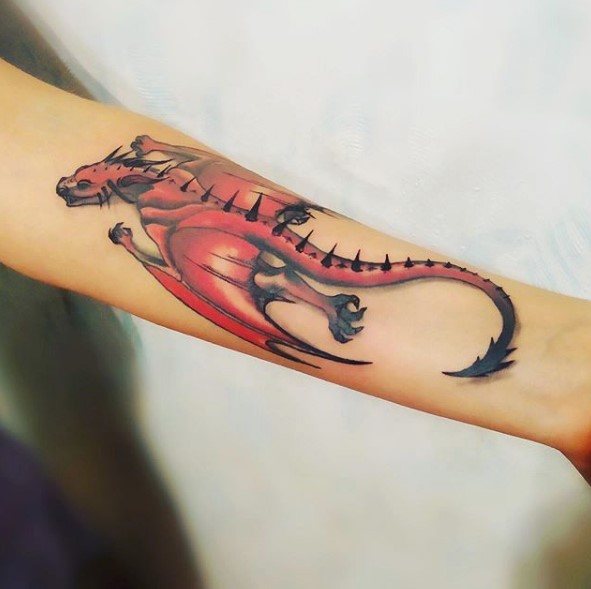
European (western)
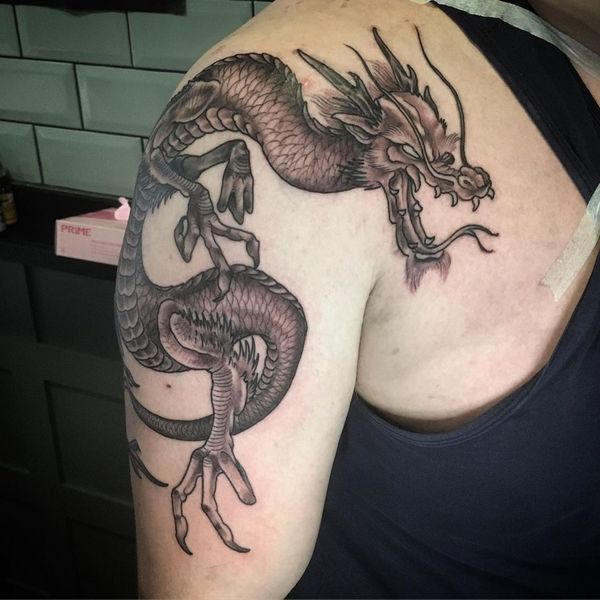
Asian (eastern)
In Western culture, the dragon is depicted with webbed wings that look like the wings of a bat. In Asian culture, the dragon has an excessively long body, remotely resembling the body of a snake. But in all cultures, the dragon flies, has 4 paws and has scales.
Today, the dragon tattoo can be seen in Celtic patterns, as a legacy of the ancient culture of northern European warrior nations and in the genre of Chinese painting. The Chinese dragon in tattoos is a very "flexible" image. The fact is that its body can be manipulated in such a way that you can advantageously cover a large area of skin that is planned to be scored.
In this case, the dragon tattoo can fit on two or more popular places, for example, it can be applied at the same time on the shoulder blade of the back, take a decent chunk of the shoulder and go head on his chest. Or go up from the forearm wriggling and wrapping around the arm and out somewhere around the neck.
This is what concerns the Asian versions of the dragon tattoo, as for the others, they are prototypes of small and friendly dragons, which can easily fit on small areas of the skin.
From the life of stars
The extravagant singer Pink decorated her leg with a dragon tattoo, and the beautiful Angelina Jolie can boast of as many as two tattoos with the mythical fiery beast. Unfortunately, one of Jolie's tattoos was shown to the public only in one intimate photo shoot of the actress and she has never "glowed" anywhere else. Rooney Mara, the actress who played the role of the girl with the dragon tattoo, naturally has a magnificent fiery snake all over her back. By the way, it was this movie that gave a new turn to the fashion for tattoos with dragons.
The division of the Dragon tattoo into styles and standard colors
Colors depend on the chosen style in which the dragon will be depicted. But in most cases, the palette is divided into two parts. Black and white options and images in color.
From specific colors is worth noting the use of the popular green in Asian tattoos and red in European for the coloring of the torso. But deviations from the standards based on individual approach to the tattoo within the style and personal preference for a certain color scheme are also possible. About the most popular styles in men and girls, we will discuss in more detail below.
Dragon in the style of Abstraction
Abstract mythical creature is very rare in the collection of popular Dragon tattoo designs. Most prefer its instant 100% recognizability, and the style is the opposite of the classical methods of artistic representation. It must be discerned, seen through the screen of the artist's boundless imagination. He is a figment of the imagination, incompatible with reality, but is a complete work of art.
Dragon in the style of Watercolor.
In most variations of watercolor dragon tattoos, several of the constant trends in the way the creature is displayed are noted. First, it has wings (the European version) and it is almost always black.
The point is that the black color contrasts sharply with the colorful bright spots imitating watercolor painting on plain paper. As a result, the tattoo becomes recognizable from afar and acquires the features of a positive drawing.
Dragon in the style of Anime
Tattoo Dragon in the style of Anime - these are the characters of Japanese animated tapes. A simple one-to-one mapping of the character from the screen onto your skin. It is allowed to change the position of the body for aesthetic appearance and to build a beautiful composition. Tattoos are usually colored, fully copying the color of the cartoon characters.
One of the most sought-after anime dragons is the host of Amber River from the feature film "Gone with the Ghosts".
Blackwork style dragon.
Black is the dominant factor in the composition of the dragon image in the Blackwork style tattoo. The style is often used for the "Coverup" procedure (applying another tattoo on top of an old one) because of the large area of skin coverage due to the flared wing, which can hide a small, underdone tattoo. In addition to the black image of the main character, the backdrop can be black, which serves the same function.
Another reason for choosing the style is the popularization of Blackwork by modern representatives of show business.
Dragon in the Graphic style
The dragon tattoo in graphics is popular among European representatives of this mythical species. They are embittered, intimidatingly baring their jaws, displaying a huge number of sharp fangs. Spiny, bony spines protrude from the animal's spine, and its webbed wings have deadly claws at the fold.
The style depicts it either as a whole creature or just its grinning mouth. In black and white versions, as well as in color counterparts, the grins are predominantly preferred by men. Girls tend toward less aggressive forms.
For some reason it is believed that the graphic is a monochrome pencil drawing. This is partly true, but not entirely true as the style can also be in color. Colored Dragon tattoos in this style also exist. The palette of colors has no defined boundaries, but the standard is to depict the dragon in brown and red.
Celtics-style dragon
Celtic has its own way of seeing this fabulous creature. Its motif is patterns of intertwined stripes often imitating the stripes of steel and the dragon is one of the elements of the stripes. He is literally woven into the composition of the ornament. His head is often crowned by the emergent end of the band from the general weave.
The head of the dragon was often similar in outline to the wolf's, but additional elements such as webbed wings or scales put everything in its place.
Dragon in Linework Style
The foundation of the Linework style of Dragon tattoo lies in the pronounced tendency to place emphasis on contour lines. The main contours of the silhouette is applied more broadly in comparison with those that are assigned a secondary role. The standard design is done in black paint. Shadows are not a hindrance if the priorities are set correctly, and they do not take away attention, turning the drawing into a graphic.
It is not uncommon for flowers to share the primacy with the dragon in half. Executed in the same style they are perfect when combined with a mystical creature.
Dragon in the Neotraditional style
A dragon that is formidable and terrifying to its enemies can look quite aristocratic thanks to the Neotraditional style. The style presents it in a variety of colors of a limitless palette of colors and often adorns the image with precious stones.
The tattoo is based on bold outlines of black, the inner parts of which are painted with a unique gradient, smoothly flowing from one color to another.
Newskool style dragon.
They are more like dragons than adults, if we are talking about the figure as a whole, rather than its appearance. Newscool style is funny and reminiscent of cartoon harmless characters. More in demand by girls, due to the fact that the style uses a bright eye-catching range of all kinds of colors and shades.
Tattoo Dragon in the style of Newscoil does not bear aggression, and causes a cute smile to others.
Oldschool dragon
The familiar image of the dragon for Oldschool style tattoos is a close-up head with an open red mouth filled with white fangs. Under his nose dangles wriggling thin long whiskers, and the head grows horns.
The tattoo has clear outlines, and the bright spots (highlights) are usually left just unpainted. The classic color of the mythical Oldschool toothy head is green or black. The head is not combined with other elements.
Dragon in Oriental style.
This is the most popular Asian style for dragon images on the body of Oriental lovers. Tattoos are famous for the massive area of coverage of a large area of skin. The dragon (mostly Japanese) is shaped like a wriggling animal, often its torso is gathered in rings and placed on several parts of the wearer's body.
Tattoo Dragon in the Oriental style is often made in the form of "sleeve" (from shoulder to wrist) or presented in the form of voluminous compositions on the back, chest and thighs.
Its appearance in many cases is decorated with horns, small short legs with very long claws about the size of the length of the fingers. One of its most important attributes is its long, wriggling mustache in unison with its torso. In Oriental tattoos, he is often depicted in the clouds.
Dragon in the style of the Organic
One of the most popular themes in men's Dragon tattoos, we must mention the image of his separate expressive part. Yes, that's exactly it - the eye or eye of the dragon.
Enlarged eyes, with bright pupils, on which there is a wet effect, looking at us outward from under the skin on the biceps or the inner part of the forearm. The tattoo does not carry aggression, but rather indicates the curiosity of this ancient invented animal.
Dragon in Realism Style
One of the most stunning tattoo styles of our century. Chemical dye pigments and the unique capabilities of tattoo equipment work wonders, creating truly masterpieces of body art on people's bodies.
Dragon tattoos are imbued with detailed detail to the image, which creates the effect of a real presence on the human body. One of the secrets is that the drawings on the skin are completely free of outlines, such as we have seen them in other styles.
Dragon in the style of Sketch.
Distinctive characteristics of the Dragon tattoo in the Sketch are rough sprawling pencil strokes, such as if they were on the original sketch. On such sketches form the initial idea, for this considering the place of the future tattoo and the desire of the client, what should be the appearance of a mythical creature. With quick movements, the artist sketches the image, which is not subsequently detailed, but simply transferred to the skin.
All dragon tattoos in this style are single-color.
The dragon in Trible style.
A wildly popular tattoo in the 1990s. Trible, itself as a style, was at its peak at the time, and the Dragon tattoo was so easy to see in many sunbathing men and girls on the beach. Men preferred to put it on their chest, arm or leg. Girls did on the waist, back, ankle and bikini area. No one was confused by the fact that the design of this tattoo was the same for most.
The tattoos were usually done in black.
Dragons - from fearsome predators to gods.
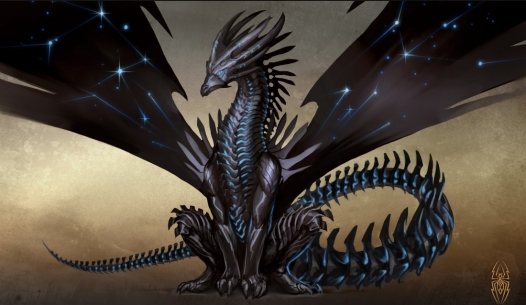

All dragons known to mankind are brought together here. What they are called, the properties inherent in dragons and the perception of dragons by different cultures of mankind. A dragon is a mythical creature, typically depicted as a large and strong snake or other reptile endowed with magical or spiritual qualities. Dragons have certain abilities typically associated with them in almost all cultures of the world.
Origin of the word The word "dragon" comes from the Greek drakon
(genitive case;
drakontos
), which means "serpent, sea fish." The lexical root of the word is.
drak
or else
derkesthai
"to see clearly." The literal translation of the meaning of the word
drakon
from the Latin "to see alone."
A brief overview Dragons are usually depicted as snakes or reptiles, hatching from eggs and possessing extremely large, usually scaly, bodies. They are often depicted with large eyes. This feature is the basis of the word "dragon" in the local dialect in many cultures. Also often (but not always), dragons are depicted with wings and fiery breath. Some dragons have no wings at all, and are more like long snakes. Dragons can have different numbers of legs: none, two or four. In the modern view, dragons are very large in size, but some early European descriptions of dragons indicated that they are the size of a bear, and in some cases even smaller - the size of a butterfly. Although dragons (or dragon-like creatures) are present in legends throughout the world, different cultures have represented them differently. Chinese dragons and Oriental dragons in general, are usually benevolent, while European dragons are usually malevolent (there are exceptions, of course). Malevolent dragons are also present in Persian mythology, and in other cultures. Dragons are especially popular in China. There they make figurines of them and then use them in celebrations. Dragon figurines are often kept in homes, and have spiritual significance in various religions and cultures around the world. This is the case in many Eastern and American (Native) cultures, and in several others, and are representatives of the basic forces of nature and the universe. In many cultures they are said to be more wise than humans. At the same time, dragons have magical or other paranormal powers, and are often associated with wells, rain, and rivers. In some cultures, dragons can even speak a human language. Chinese dragon, engraving made in the style of the Chinese school, 19th century
Dragons are very popular characters in fantasy literature, role-playing games and video games. The Dragoon, an infantryman who jumps on horseback but fights like an infantryman, derives from their first firearm, the dragon, a broad musket which spewed great flame when fired, and so was named after this mythical beast.
Symbolism In medieval symbolism, dragons were often symbols of treason and betrayal, as well as anger and envy, and ultimately symbolized great evil. Several heads were symbolic of decadence and oppression as well as heresy. But they also symbolized independence, leadership and strength. Many dragons also symbolized wisdom. Killing a dragon gave not only access to its treasures, but also implied that the hero defeated the most cunning of all creatures. In some cultures, especially Chinese and Himalayan, dragons are believed to bring good luck. Joseph Campbell, in his work The Power of Myth, considered the dragon as a symbol of theology or superiority because it represents the unity of Heaven and Earth, combining the form of a serpent (earthly) with that of a bird (heavenly). The dragon-shaped drainpipe in Ulm Munster
Dragons have both masculine and feminine traits, such as in Aboriginal myths, where the dragon raises a child for future adulthood, teaching how to survive in the world. Another contrast in dragon imagery is their ability to spew fire, yet live in the ocean. That is, to combine fire and water together. Joseph Campbell's work says that they also include the opposing elements of earth and sky. Dragons represent the union of opposing forces of the cosmos.
Dobrynia Nikitich kills the Serpent Gorynych, by Ivan Bilibin
Another symbolic representation of dragons is
Ouroborus
- "the serpent that eats itself." He symbolizes eternity. Natural cycles, their beginning and end.
Drawing by Theodoros Pelecanos Engraving by Lucas Jennis (Theodoros Pelecanos), in the alchemical treatise "Synosius" "De Lapide Philisophico" Dragons in Christianity The Latin word "dragon," "draco" (genitive: draconis) actually means serpent, emphasizing the common ancient European association of dragons with snakes rather than lizards or dinosaurs as is usually done today. The medieval biblical interpretation of the Devil, who appeared as a serpent who seduced Adam and Eve, was the occasion for identifying the dragon with evil. In the biblical literature itself, such an association is virtually absent, with the exception of the "Apocalypse" (Book of Revelation) of the Holy Apostle John the Theologian. The demonic adversaries of God, Christ, and all Christians were usually represented as reptiles or chimeras.
In the Book of Genesis, chapter 41, there are references to the sea monster Leviathan, which has some dragon-like features. In "Revelation" chapter 12, verse 3, a huge red beast with seven heads, whose tail covers one third of the stars from Heaven to Earth earth (symbolizing the fall of the angels), is described. Most translations use the original Greek word "drakon" to refer to this animal. In iconography, some saints are depicted slaying the dragon. This is how St. George is depicted in Egyptian and Coptic iconography, St. George the Victorious on the coat of arms of Moscow, and St. Mercerialis in Italy. St. Jalian Le Mans, St. Veran, St. Crescentinas, and St. Leonard Norblac were also depicted slaying dragons. But there is also the belief that dragons were good, before they fell sinfully just as humans were expelled from the Garden of Eden. Also in Christianity it turns out that if dragons really existed, they were created just as well as any other creature. This is what Brian Davis wrote about in his book, Dragons Among Us.
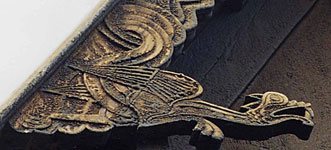

A dragon carved on the facade of the Hopperstad church in Norway
Dragons and the Chinese Zodiac The years 1916, 1928, 1940, 1952, 1964, 1976, 1988, 2000, 2012, 2024, 2036, 2048, 2060, are considered the years of the dragon in the Chinese Zodiac.
The Chinese Zodiac implies that people born in the Year of the Dragon are healthy, energetic, unrestrained, and stubborn. They are also honest, sensitive, brave and trustworthy. The Chinese Zodiac implies that people born in the Year of the Dragon are the most eccentric of all people born under any other sign. They do not like to borrow money, they do not say pompous speeches, but they have a tendency to be magnanimous, which often gives an opportunity to manipulate themselves. People born in the year of the Dragon are compatible with people born in the years of the Rat, Snake, Monkey and Cock. In East Asia. Dragons in Asia are usually symbols of good luck or health, and they are sometimes even worshipped. Asian dragons are seen as mythical rulers of weather, rain and water, and are usually depicted as guardians of pearls.
In China, as well as in Japan and Korea, the Blue Dragon is one of the four symbols of the Chinese constellation symbolizing spring. Chinese dragons are often depicted clutching a large pearl with their paw, though some say it is actually a dragon egg. The Chinese believe that dragons lived mostly under water, and sometimes give rice as gifts to dragons. Dragons are not depicted with wings like European dragons because it was assumed that they could fly using magic. Yellow dragon. (Huang long)
with five claws on each leg, symbolizes the change of seasons, the earth element (which is a kind of Chinese 'fifth element') and the center. In addition, it symbolizes the imperial power in China, and we can say that all Chinese. Chinese people often designate their origin as "Descendants of the Dragon" as a sign of ethnic identity. The dragon is also a symbol depicted on coins in Bhutan (the coin is called
Druk Gyalpo
, or King Dragon). In Vietnam, the dragon is the most important and sacred symbol. According to an ancient myth of the creation of men "
Kinh
", all Vietnamese people are descended from dragons. The eldest of their 100 sons founded the first dynasty. The image of Naga, a minor deity that takes the form of a snake, is often found in Buddhism and in Buddhist traditions. Technically,
Naga
is not a dragon, although it is often presented as such. The term is ambiguous, referring to both the tribe of people known as "Nagas" ("Nagas") and to elephants and common snakes. Within the mythological context, Nagas referred to a deity taking the form of a serpent with one or more heads. Sometimes the Buddha is depicted sitting on a coiled snake, with several snake heads crawling over his body. This is Mucalinda, the Naga protecting the Buddha during his training. People unfamiliar with Buddha's history see only the head of Mucalinda and think he is a dragon, not a snake-shaped deity. The railing of the staircases in Buddhist temples is often made to resemble the body of Nagi, with the head at the base of the railing. In Thailand, the head of the Naga, presented in an even more unusual form, is often seen on the corners of the roofs of houses, while the body of the Naga adorns the pediments. That is, Naga as if to protect the house.
Naga the guardian of the temple of Wat Sizaket in Canal Viang, Laos
In Hindu mythology,
Manasa
и
Vasuki
- serpent-like creatures, or dragons. Indra, the Hindu god of the storm, killed Vritra, a large serpent living on a mountain. The Vietnamese dragon is a combined image of a crocodile, a snake, a lizard, and a bird. Historically, Vietnamese people lived near rivers and were very afraid of and revered crocodiles. The Vietnamese called them
Giao long
". It is the first kind of the Vietnamese dragon. Then, many kinds of dragons appeared in architecture, painting, literature and in the minds of the Vietnamese. There are many legends of serpents or dragons in Greek mythology, in which usually the serpent or dragon guards some treasure. The first kings of Athens, according to legend, were half man and half serpent. Dragon
Ladon
guarded
the Golden Apples of the Sun.
that belonged to the Hesperides. Another serpent dragon guarded the Golden Fleece, protecting it from theft by Jason and the Argonauts. Similarly.
Pythia
и
Python
a pair of snakes, guarded the temple of Gaia and his oracle, before the Delphic oracle was captured by Apollo, who decorated his winged caduceus with the skins of these snakes, which Hermes gave him. The Greek myths of Hercules, Ladon, and others are thought by some to be based on an earlier myth from Canaan in which the Israelite god Yahweh overcame Leviathan. These stories also go back to even older stories of Hittite or Harrian, who had to overcome the dragon
Illuniacas
who lived in the sea. In the mythology of the Aborigines of Australia,
the Rainbow Snake
was a hero of myth in many parts of Australia. It has been known by various names in places from Waugal, in the southwestern Niagara, to the Ganba Desert in the north, to the Wanambe in southern Australia. The rainbow snake, associated with lakes and rivers, was to be respected and feared.
The assumption about the origin of dragons Where the original concept of "dragon" came from is currently unknown, as there is no generally accepted scientific theory, and there is no evidence to support the existence of dragons now or in the past. While the very existence of dragons may be true or false, it is an undeniable fact that dragons are present in myths in a great many places that have had no contact with each other. It has been suggested that dragons may be some kind of common human representation of the creature, along with common psychological tendencies among groups of humanity. Some speculate that the dragon may have had a real prototype from which various legends arose. Dinosaurs, for example, or other archaeosaurs. But there is no evidence to support this hypothesis, only alleged sightings studied within the framework of cryptozoology (a targeted search for animals whose existence is not proven or considered impossible in a given area and/or at a given time (for example, the Loch Ness monster, Bigfoot, etc.)). According to this hypothesis, there are giant lizards like Megalania
(Megalania), which are descendants of dinosaurs. All of these hypotheses are believed by many to be pseudoscience or myth. The first dinosaur fossils found were once thought to be "dragon bones. This discovery, made in 300 B.C. in Sichuan Province in China, was called
Chang Qu.
. It is unlikely, but there is a chance that it was this discovery that caused or strengthened the legends of flying monsters. Herodotus, often called the "father of history," visited Judea in 450 B.C. and wrote that he had heard of caged dragons in neighboring Arabia, near Petra in Jordan. Out of curiosity he traveled to these places and found many skeletal remains of snakes and collected many reports of flying snakes flying from Arabia to Egypt but being repelled by Ibis. According to Marco Polo's journals, when he was going through Anatolia to Persia, he came across real live flying dragons that attacked his personal caravan in the desert. He reported that the dragons were very frightening animals that nearly killed him when he was attacked. Polo did not record this story immediately in a journal, but dictated it to his cellmate while he was in prison, and at this point there is much debate as to whether this man could have simply invented a dragon to embellish Marco Polo's story. Polo was also the first Westerner to describe Chinese "dragon bones." These bones were apparently fossils described in Chang Qu, or bones of other animals.
The ancient Mesopotamian god Mardak and his dragon, on the Babylonian seal
There is another hypothesis put forward by proponents of the catastrophe theory. It says that comets and the lines in the sky they form gave rise to legends of flaming serpents in the sky. In Old English, comets were sometimes called fyrene dracan or fiery dragons. Volcanic eruptions may also have been responsible for reinforcing belief in dragons, although eruptions in European and Asian countries were rare.
St. George slaying the dragon. Red dragon on the Flag of Wales Painting by Paolo Uccello, 1470.Classification of dragons Russian dragons
Origin
Title
Description
Slavic dragons
Serpent, serpent, Zmay.
Similar to European dragons, but with many heads. They exhale fire and leave a trail of flame as they fly. In Slavic culture and related, dragons symbolize evil. Dragons are often given Turkic names (eg, Zilant), symbolizing the long conflict between the Slavs and Turks.
Tatar dragons Zilant resembles a winged snake. Zilant is the symbol of Kazan. Zilant himself is the Russian personification of the Tatar dragon, that is, the snake.
Siberian dragonYilbegan Similar to European, Turkic and Slavic dragons
Chuvash DragonsVere Selen The Chuvash dragons represent the pre-Islamic mythology of this republic.
European dragons
OriginDescription
Scandinavian and Germanic dragons Lindworm (lindworm) Also called "Snake Dragon" is a very large wingless snake with two legs. But the Lindworm is actually closer to a winged dragon. Such dragons were thought to eat cattle and symbolize pestilence. On the other hand, seeing a Lindworm was considered good luck. The dragon Fafnir, slain by the legendary hero Sigherd, was called ormr ('worm') in ancient Norse. He was indeed a giant serpent. He did not fly, nor did he exhale fire. On the other hand, the dragon slain by the English hero Beowulf did fly and breathe fire and was actually a European dragon.
The Welsh dragonҮ Ddraig Goch, Zomok The red dragon is a traditional symbol of Wales and can be seen on the Welsh national flag. A large snake living in a swamp that regularly kills pigs or sheep. But it can easily be killed by a few shepherds who go hunting for it.
Hungarian Dragons Sarkanyok Sarkanykigyo Sarkany A giant winged snake that is actually a grown Zomok. Often uses garabonciasok (a special kind of magic). Sarkanikigio controls storms and causes bad weather. A dragon in human form. Most of them are giants with many heads. Their power lies in their heads. If they lose their heads they become weak.
Romanian DragonsBalaur is very similar to the Slavic serpent. Very big, and with many heads.
Austrian DragonsCuelebreIn Austrian mythology, Cuelebre are giant winged serpents that live in caves, where they guard treasures and kidnapped Hanas (nymphs). They can live for centuries and, when they become quite old, they begin to use their wings to fly. Their breath is poisonous and they often kill cattle for food. The Austrian word Kuelebre comes from the Latin colubra, meaning snake.
Basque DragonsHerensuge (Herensuge) SagaarIn Basque it means "dragon." According to legend, Saint Michael, descended from heaven to kill Herensuge, but only when God agreed to accompany him. As Michael was frightened by the creature. One of the gods of Basque mythology, also called Maju, was similar to a snake, although it could take other forms.
Asian dragons
OriginDescription
The Indonesian dragon Naga or Nogo Naga is a mythical animal of Indonesian mythology. Her myth covers almost all of Indonesia's islands, especially those influenced by Hindu culture. Like its Indian counterpart, the Indonesian naga sees this as something divine in nature. It is benevolent, and is often associated with sacred mountains, forests, or certain parts of the sea. In some parts of Indonesia, the dragon or Naga is depicted as a giant snake with a golden crown on its forehead. And there is a belief among some Indonesian peoples that Nagas still exist on uncharted mountains, lakes, and active volcanoes. In Java and Bali, dragons are represented as perfect beings that the gods sent to earth to support the goodness and prosperity of people. Some who live there claim to have seen this legendary animal and see it as a good omen. But if dragons spoke to them, it was considered a warning of trouble or bad luck.
Chinese dragonLungA light creature with a long, serpentine shape, united with various traits of other animals. Most (but not all) are wingless. The creature has four claws on each leg (five on the imperial emblem). They are the lords of weather and water, as well as a symbol of power. They can carry dragon eggs in their paws, although according to some sources they are pearls.
Japanese dragonRuy (Ryu)Similar to Chinese and Korean dragons, but with three claws instead of four. They are benevolent (with some exceptions) and can grant wishes. Rarely seen in Japanese mythology.
Vietnamese dragonLongo Balaur is very similar to the Slavic serpent. Very large, and with many heads.
Austrian DragonsCuelebreThe bodies of these dragons curve in 12 waves, which symbolize the 12 months of the year. They can influence the weather and are responsible for the harvest. On the back of a dragon - a few horns. The head has a long mane and beard. Big eyes, crest on the nose, but no horns. The mouth is depicted large and open, with a long, thin tongue. They always hold a jewel in their mouth (a symbol of humanity, nobility, and knowledge).
The Korean dragon Yong (yo) Kyo (kyo)The heavenly dragon essentially corresponds to the Chinese Leung. Like Leung, Yong, and other Korean dragons, control water and weather. The hornless ocean dragon, sometimes called the sea serpent. A dragon that lives in the mountains.
Indian DragonsViali (Vyalee) and NagaThere is some debate as to whether Vyalee can really be considered a dragon. It was found in ancient temples where the goddess Parvati was worshipped. The naga is the chief dragon of Indian and Hindu mythology. Nagas are magical serpents that live in water. Their king wears a golden crown on his head. The Nagas are associated with the Buddha and mainly with the god Vishnu and his incarnations, the Dasavataras. When Krishna was still a child, he fought the Naga who took over the water of the lake.
American Dragons
OriginTitleDescription
The Central American dragon AmphitereA winged deity who takes the form of a snake. He was supposed to give knowledge to mankind. Sometimes was also a symbol of death and the beginning of a new life.
Inca dragonAmaruThe dragon (sometimes called a serpent) in Inca culture. The last Inca emperor, Tapak Amaru, had a name that translates to "Dragon of the god."
Brazilian dragonBoy-tataA dragon-like creature (sometimes, snake-like), in Brazilian culture.
Chilean dragonsCaicaivilu and TentenviluDragons in the form of a snake. Caicaivilu was a sea god and Tentenvilu was a land god. Both originated from the Chilean island of Chiloé.
African Dragons
OriginTitleDescription
The African dragon Amphisbaena probably first appeared in northern Africa (and later myths about him moved to Greece). Amphisbaena was a two-headed dragon (one head was in front, the other at the end of his tail). The front head held its tail (or neck, as the case may be) in its mouth. That is, the dragon created a wheel from its body that allowed it to roll.
Dragon-like creatures
NameDescription
Basilisk The basilisk is a descendant of the union of a rooster and a snake. It resembles a lizard, or snake, and can kill with its gaze, voice, or by touching its prey. Like Medusa, the basilisk can be killed if it sees itself in a mirror.
LeviathanIn Jewish mythology, Leviathan was a large creature with huge teeth. Modern translations present Leviathan as a crocodile, but in the Bible, Leviathan can breathe out fire, can fly, cannot be penetrated by a spear or harpoon, can crawl up steep walls, its teeth are very close together, could swallow a man whole, so it is not much like a crocodile. For a long time, the word has been used to refer to any large sea creature. In modern Hebrew, "Leviathan" simply means whale. Leviathan is more like a snake and lives in water.
Winged dragonThe winged dragon is more similar to a regular dragon than any of the other creatures listed here. A winged dragon is a winged snake with two legs or no legs at all. The winged dragon is often used in heraldry, where it is very different from the four-legged dragon.
SnakeDragon comes from the Slavic dragon. Snake takes on the guise of a man, can fly and breathe out fire.
cockatriceA bird-like reptile often confused with the Basilisk. In Gerald Derrell's book, they make an attempt to kill all the dragons by stealing the last eggs
Quetzl)Central American or Mexican creature with both scales and feathers worshipped by the Toltecs and Aztecs. Also called the Feathered Serpent.
Famous dragons are.
Azhi Dahaka
Was a three-headed demon, often described as looking like a dragon. It is part of Zoroastrian mythology.
Ugarian myth describes a seven-headed sea serpent named Lotan
.
Hydra
In Greek mythology, a water snake with many heads and magical powers. When one head is cut off, two more immediately grow in its place. This creature was defeated by Hercules.
Smoke Wawelski.
- Polish dragon that terrorized all the hills around Krakow in the Middle Ages.
Y Ddraig Goch.
(Y Ddraig Goch) is a symbol of Wales, originally depicted as the red dragon from the Mabinogion story of Lludde and Llewelis.
Needhogg
- A dragon from Norse mythology who was said to live in the darkest part of the Underworld, waiting for the arrival of Ragnarok, who would free him to give vent to the destruction in the world.
Orochi
- The eight-headed serpent slain by Susanoo in Japanese mythology
Dragons on emblems A dragon is the emblem of Ljubljana, Slovenia. The city has a dragon bridge, which is decorated with four dragons. The city's basketball club nicknamed the Green Dragons. The city's car license also contains an image of a dragon.
Y Ddraig Goch (Welsh for "Red Dragon") is depicted on the national flag of Wales (the flag itself is also called "Y Drag Goch").
This dragon is the most famous in Britain. There are many legends about him.
Perceptions of the creature
According to illustrator Todd Lockwood, dragons have much in common with cats, which is expressed in their structure and character, but they cannot resemble snakes or lizards. Dragons must have developed muscles in order to fly. The artist also considers them intelligent creatures[14]
Similarly, the main character in the "How to Tame a Dragon" series of books by British children's author Cressida Cowell is depicted as a dragon with various cat-like habits, the same goes for the film adaptations of the books ("How to Tame a Dragon," etc.).
Dragons in fantasy and video games:
Alduin of Skyrim - His nickname "World Eater" comes from Norse myths, which describe him as a terrible, fierce firestorm that destroyed the previous world to begin this one. For this reason, the Nords see him as a god of time both creator and harbinger of the apocalypse. He does not head the Norse pantheon, but he is its source, albeit a grim and frightening one.
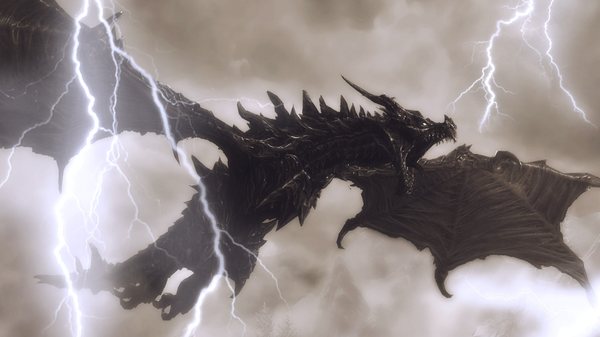

Galakrond is a giant protodragon, the progenitor of the entire dragon race in the world of Azeroth from the game Warcraft, who went mad and terrorized all his children.
He was the threat against which the five protodragons of different colors - the future Aspects - united.
It is believed that the aspects were created by the titans. However, this is just a rumor, so that the truth about Galakrond remains closed to most dragons.
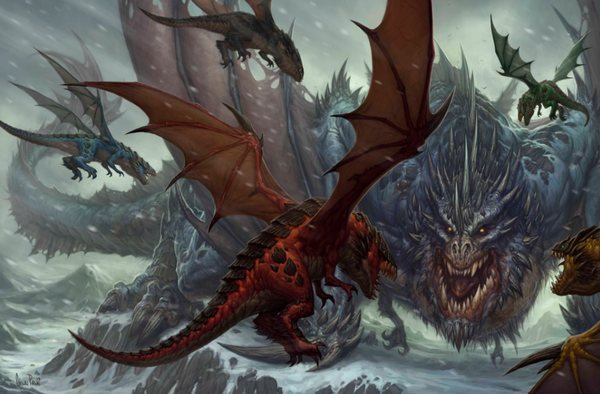

I would also like to touch on another boss of this game.
The third World of Warcraft expansion Cataclysm, released in 2010, saw drastic changes when the dragon Deathwing wreaked havoc across Azeroth. Destruction affected entire locations and changed the world around it. Naturally, Deathwing became the final boss of the add-on and a ferocious foe for players. Years have passed, and now you can humiliate Deathwing by riding a dragon-mount in his likeness, so he won't forget who defeated him.
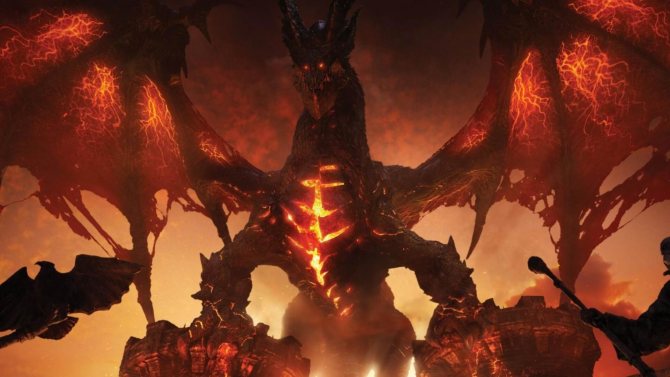

Ancalagon is the first winged dragon of Middle-earth, the ancestor of all winged fire-breathing dragons. Winged dragons represented the last reserve of Morgoth's forces in the War of Wrath. Thanks to their onslaught, for the first time in the war, the Dark Lord was not only able to stop, but also to turn back the forces of Valinor that were advancing on Tangorodrim.
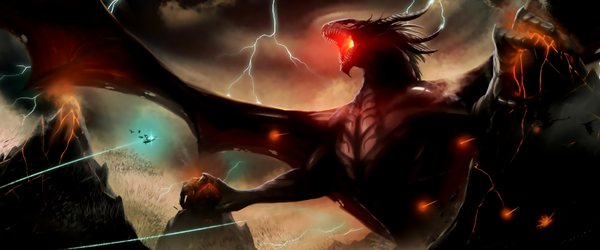

Balerion is Aegon the Conqueror's dragon during the War of Conquest. Also known as the Black Terror. He was the largest and oldest dragon of the Targaryens and of all Westeros. It was so large that its shadow could cover an entire city.
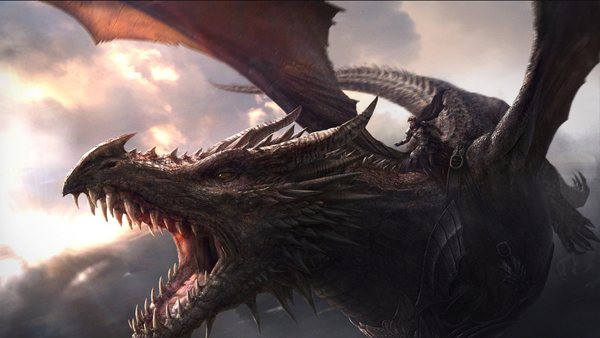

Willentrenmert (also known as Borch the Three Galleys) is one of the strongest dragons of Sapkowski's stories - The Witcher. He is a unique golden dragon, able to change his appearance to human or any other.Golden dragon is the rarest and most legendary type of dragon. Its scales have a golden hue. It was he who later gave birth to his daughter Saskia, the heiress to his gift or curse.
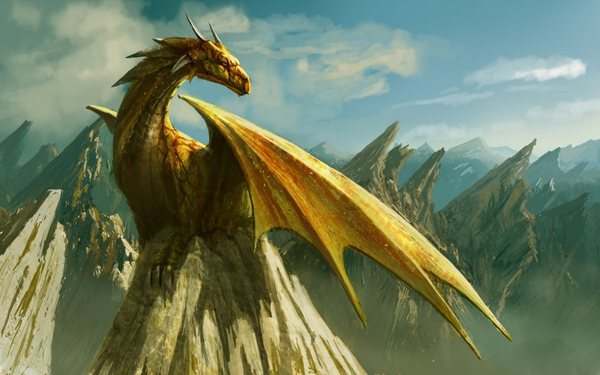

Saesentessis is the daughter of the golden dragon Willentrenmert, better known as "Borch the Three Galleys," and probably the green dragoness Mirgtabrakke. Since Saskia is not a pure-blooded golden dragon, she is unavailable with all of her father's polymorphic abilities, and can only be either a dragon or a human.
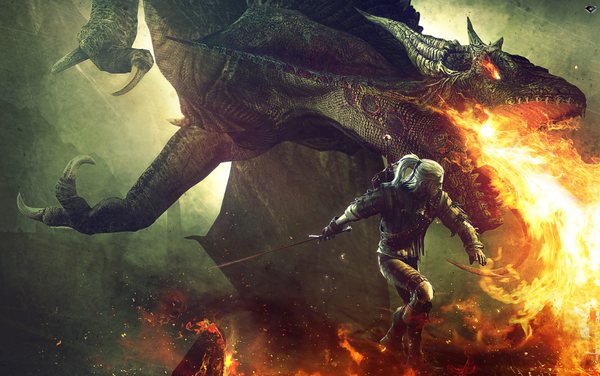

Ukrainian Armor - The largest and strongest dragon in the world of harry potter. It weighs up to six tons and is slow and clumsy in flight, but it can crush an entire house with its own carcass. Its scales are metallic gray, its eyes are deep red, and its claws are long and dangerous. These dragons have been closely watched by the Magical Magistrate of the Ukraine, ever since an Armored Dragon dragged a sailing ship into the Black Sea in 1799 (luckily, it was empty).
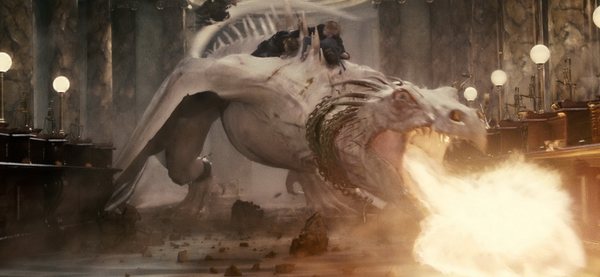

The Ancient Dragon is the biggest and strongest Dragon of Dranglik. In fact, the dragon is not a real dragon, but still a dragon. After examining the location Aldia's Citadel, in one of whose rooms you can find the bodies of giants piled up in the mountain, you can make the assumption that Aldia created this dragon from the Soul of a giant, it is confirmed by the fact that after killing it you get only the Soul of a giant.
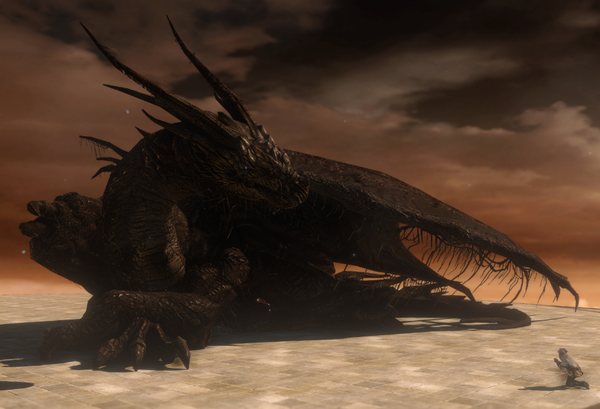

"Undead Dragon - The strongest and most survivable dragon in the world of Gothic. Virtually Immortal. Located in its own chambers on the island of Irdorath. The most important dragon, lord of all the undead, in particular the Seekers and Orcs.
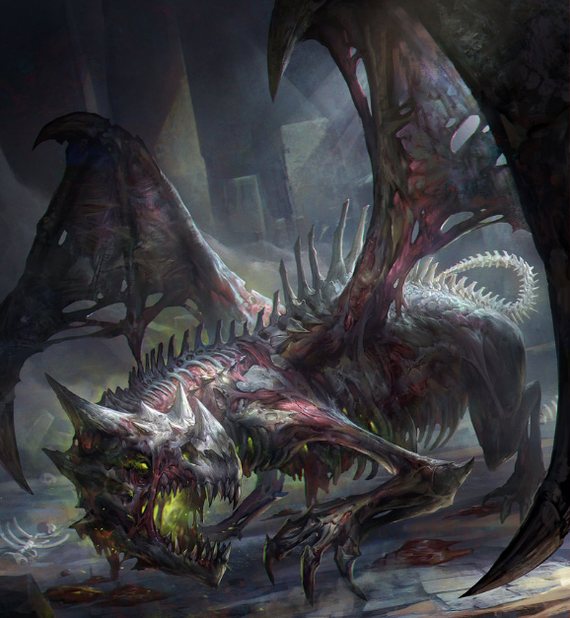

Draconiha is the wife of Donkey. She guards Fiona's tower in "Shrek." The dragoness first appears while guarding an abandoned castle, which serves as Princess Fiona's prison. We can assume that this is her long-standing, permanent residence, as the tower holds a lot of treasure and the castle happens to be strewn with the bones and armor of many unfortunate knights who have tried to save Fiona. One can only imagine how many warriors, soldiers, and knights she has incinerated with her breath.


In the world of Heroes of Sword and Magic, dragons since Part 5 are not just "giant winged fire-breathing reptiles," but are the original gods and the embodiment of magic.
The inhabitants of Askhan know of their existence and venerate them, even tremble before them.
In their names they swear oaths, and in their presence
Compositions with other elements
The dragon can be applied to the body as a single character settling on the skin or soaring in the clouds spreading its wings, in the European version. But in some compositions, it is combined with other equally famous objects or living elements of fauna, creating a deliberate plot, filled with meaning.
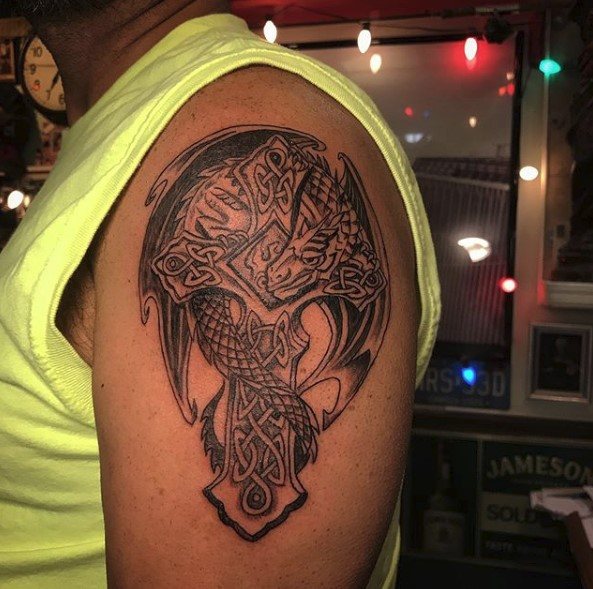

Often the dragon is combined with a Celtic cross made in the style of Celtic, this European symbol, decorated with different patterns and intertwining. In Chinese culture it is combined with a pearl, giving the tattoo a special meaning. And also in the East it is customary to depict the dragon along with the tiger, as the two opposing sides.
In some compositions, whether female or male, the dragon is decorated with an addition in the form of flowers.
Who is suitable?
It is interesting that both beautiful girls and masculine guys have a weakness for tattoos depicting a dragon. At the same time, among fans of winged monsters, there can be very different people. Unfortunately, many are guided by aesthetics and do not know what their fiery talisman means.
Tattoo in the form of a dragon is suitable for power and self-confident people whose actions are based on noble principles. However, do not forget that the dragon is a militant symbol. Wearing it on your body means not denying yourself the pleasure of challenging and crushing to victory.
Popular places to apply it
Now we know by what signs you can distinguish the eastern dragon from the European one, and here is where they like to apply it most of all, let's figure it out.
Girls prefer to apply the image in a large scale on the side of the hip, on the back and on the arm. Smaller images are applied on the forearm and shin. There are less popular places such as calves and ribs.
Men love large scale images, so they do on the chest, back, shoulder and forearm. And they even combine these areas of skin in one stunning story, united by one common name - the dragon tattoo.
